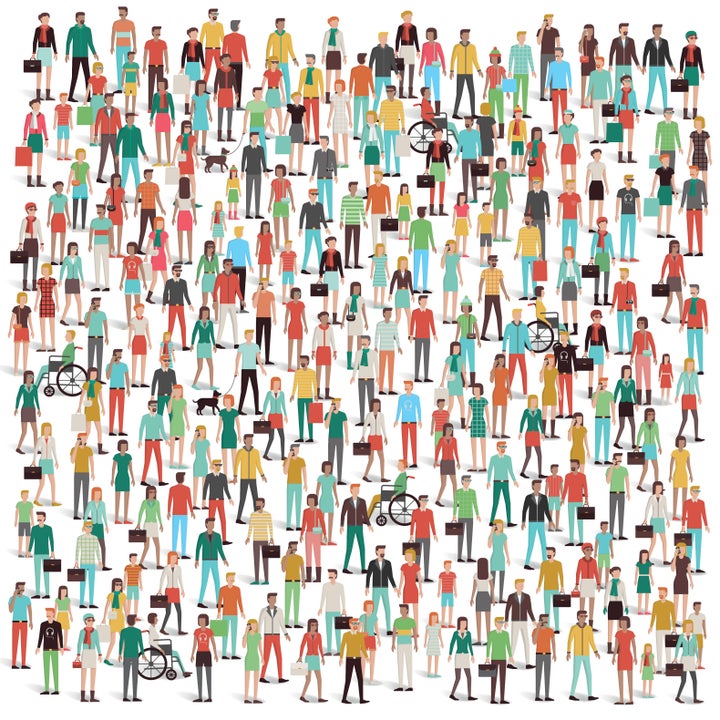
Anxiety disorders like social anxiety disorder, obsessive compulsive disorder, agoraphobia, panic disorder and general anxiety are the most common forms of mental illness in the U.S. An estimated 18 percent of all American adults have an anxiety disorder, costing more than $42 billion a year.
America is unique in this regard, according to the largest ever global analysis. Some regions of the world, including the U.S. but also Western Europe, have higher rates of anxiety disorders in general. What's more, some groups within the U.S. have a higher risk of anxiety disorder diagnosis than others.
Olivia Remes, lead author of the analysis and an anxiety researcher at the University of Cambridge, reviewed 48 of the best or most comprehensive studies on anxiety prevalence around the world and was able to pinpoint which cultures, genders and age groups are most likely to be affected. The results also revealed where there are gaps in understanding among some groups.
“Much more research needs to be done on people identifying as lesbian, gay, and bisexual (LGB), because anxiety is an important issue in this group,” Remes said. "Also, Aboriginal people living in Canada, the U.S., New Zealand, and other parts of the world are at a significantly increased risk for poor health, yet we know so little about their mental health."
Why anxiety disorders matter
Despite how common they are, anxiety disorders continue to be belittled as mere worrying instead of debilitating, disabling conditions that require treatment.
While a little bit of anxiety can be beneficial by helping us keep safe, people with untreated anxiety disorders experience overwhelming, uncontrollable feelings of dread or fear that can interfere with daily life and prevent them from doing the things they want to do. Learning more about these conditions is one way to help combat mental health stigma and get help to the people who need it.
“[Anxiety disorders] can increase the risk for suicide, disability, and poor quality of life,” Remes said. "If we don’t know who is most affected by anxiety, we cannot do anything to decrease the human and economic burden associated with these disorders."
Here are 10 takeaways from this landmark global study of anxiety:
1. Women are twice as likely to be affected by anxiety disorders as men.
Women were more likely to be affected by anxiety disorders than men by a ratio of 1.9 to 1, and these difference persisted across time and in both developing and developed countries.
2. Young people are more likely to have anxiety disorder.
No matter what culture was studied, people under the age of 35 were more likely to have anxiety disorders than older people. This held true for all researched countries except for Pakistan, where middle aged people have the highest rates of anxiety disorders.
3. Opioid addiction is linked to an increase in the risk of anxiety.
Globally, the presence of anxiety symptoms in people who abuse opioids range from two percent to 67 percent, while actual diagnoses are about 29 percent. Among Americans who abuse opioids, that number is 16 percent.
4. People who suffer from gambling or internet addictions are more likely to also have anxiety disorder.
In addition to opioid abuse, pathological gambling and internet addiction are two other risky behaviors that appear to be linked to an increase in anxiety diagnoses. Globally, 37 percent of pathological gamblers reported having anxiety disorders, while studies on internet addiction (mostly in Asian countries) find that anxiety prevalence is more than two times higher in people with internet addiction compared to control groups.
5. Anxiety often appears with other mental and neurological illnesses.
People with bipolar disorder, schizophrenia and multiple sclerosis are at greater risk of an anxiety disorder. In Europe, a range of 13 to 28 percent of people with bipolar disorder have anxiety too, while globally, 12 percent of people with schizophrenia have also been diagnosed with obsessive compulsive disorder. Finally, almost 32 percent of people with multiple sclerosis, which is a neurological condition, have an anxiety disorder, and over half of them have some anxiety symptoms.
6. Seemingly unrelated diseases are linked to heightened rates of anxiety.
People with cardiovascular disease, cancer, respiratory disease, diabetes and other chronic conditions are more likely to have anxiety disorder. For instance, symptoms of anxiety among people with congestive heart failure ranges from two to 49 percent. People with coronary artery disease have panic disorder at rates ranging from 10 to 50 percent.
Cancer patients, meanwhile, had anxiety rates between 15 to 23 percent. This heightened risk can extend even to cancer survivors and their spouses. Globally, people who had been diagnosed with cancer two years ago had higher anxiety rates than healthy controls (18 percent vs. 14 percent), and 40 percent of spouses of long-term cancer survivors developed anxiety.
7. Anxiety can be present in people with chronic, non-life threatening conditions.
People with diabetes are more likely to have either anxiety disorders or anxiety symptoms compared to healthy control groups, and this effect was stronger for women than men. For instance, women with diabetes had anxiety prevalence at almost two times the rate of men with diabetes, at 55 percent compared to 33 percent.
8. A traumatic past could explain high rates of anxiety.
People who experience trauma can also have unusually high rates of anxiety. Studies of U.K. and U.S. veterans who had limbs amputated find that anxiety affects one-fourth to over one-half of these groups. Globally, people with a history of sexual abuse report anxiety rates that range from two percent to 82 percent.
9. Anxiety is something to watch for during pregnancy.
Globally, pregnant and postpartum women have higher rates of obsessive compulsive disorder than the general population. That’s two percent and 2.4 percent, respectively, compared to 1 percent of the general population.
Ethiopian and Nigerian studies showed that anxiety was high in women during the pre- and post-natal period (15 percent and 14 percent, respectively), and that this effect was especially pronounced in younger women.
10. Vulnerable subgroups are more prone to anxiety.
Lesbian, gay or bisexual people living in Western countries have higher than normal rates of anxiety, and this effect is strongest for women. An estimated three to 20 percent of men face anxiety, while the estimate for women ranges from three to 39 percent.
Anxiety symptoms are also most common in old age, especially among those who have cognitive dysfunction, such as memory problems. Among seniors with mild cognitive impairment, an estimated 11 to 75 percent face an anxiety disorder. This extends even to their caregivers, who report anxiety in the range of four to 77 percent.
Remes hopes that her research highlights populations who are most affected by anxiety, so governments and health care systems can direct mental health resources, interventions and screening efforts toward these high-risk groups.
"Hopefully our study will raise awareness of anxiety as an important issue so that more research can be conducted on this, and those affected can seek help and receive the necessary treatment," Remes said. "Mental health is important for all and is a basic human right."
CORRECTION: This article has been updated to address language that inaccurately characterized multiple sclerosis as a mental health issue.
